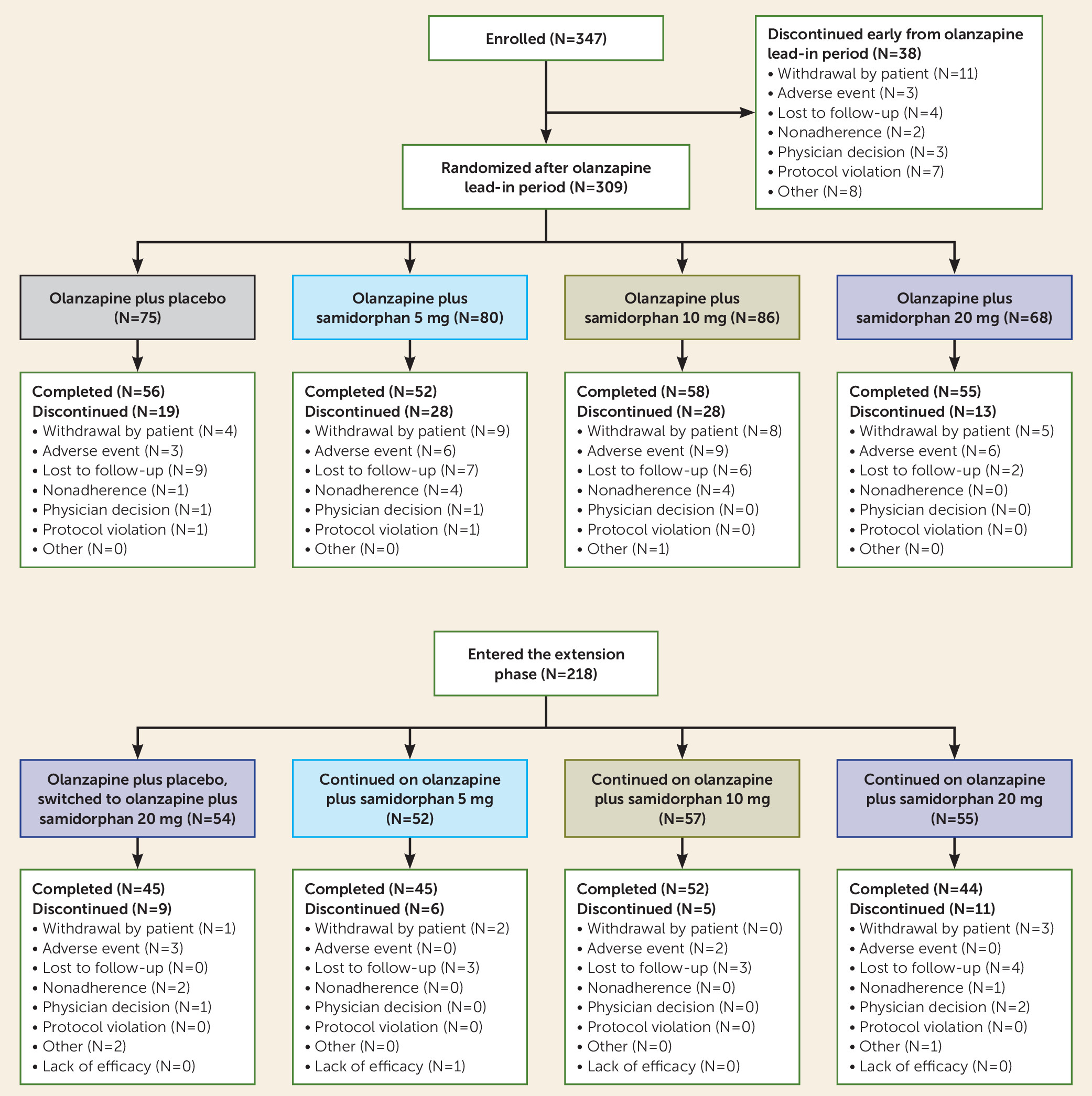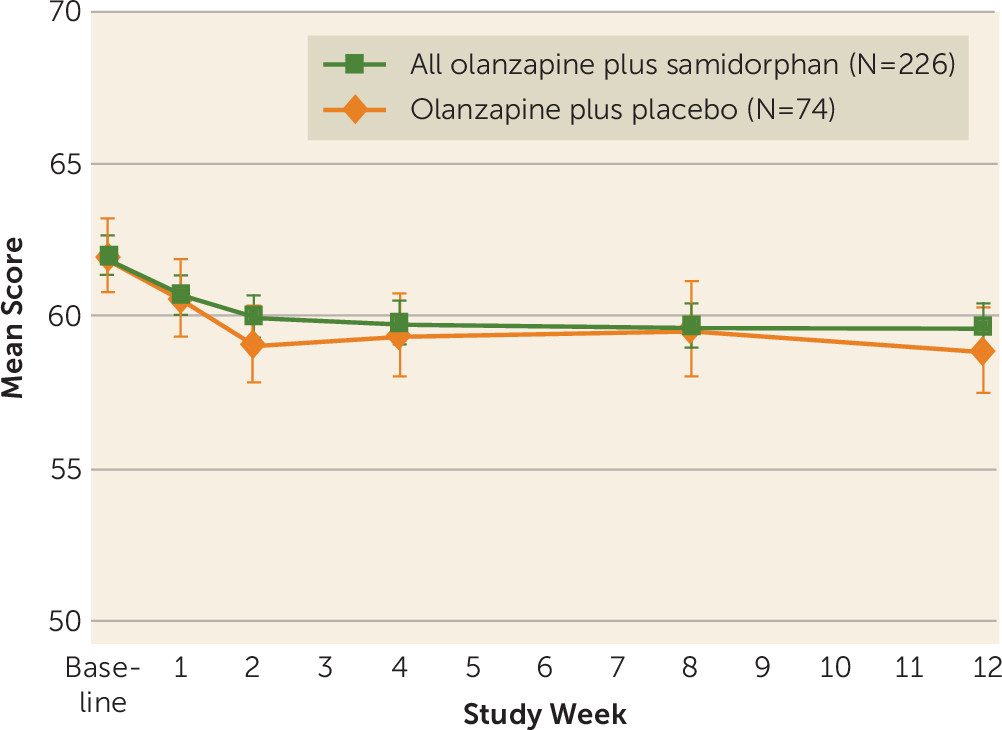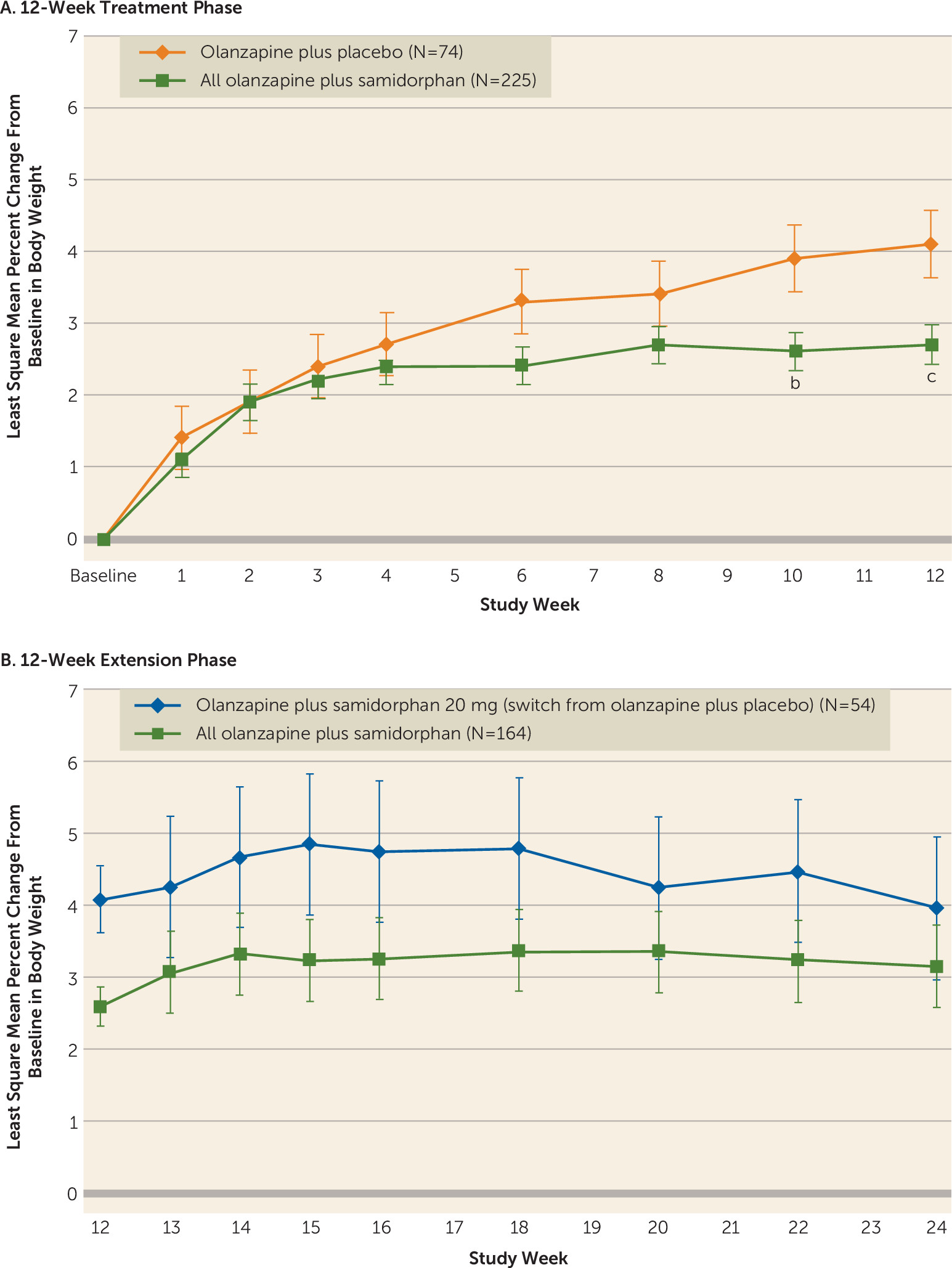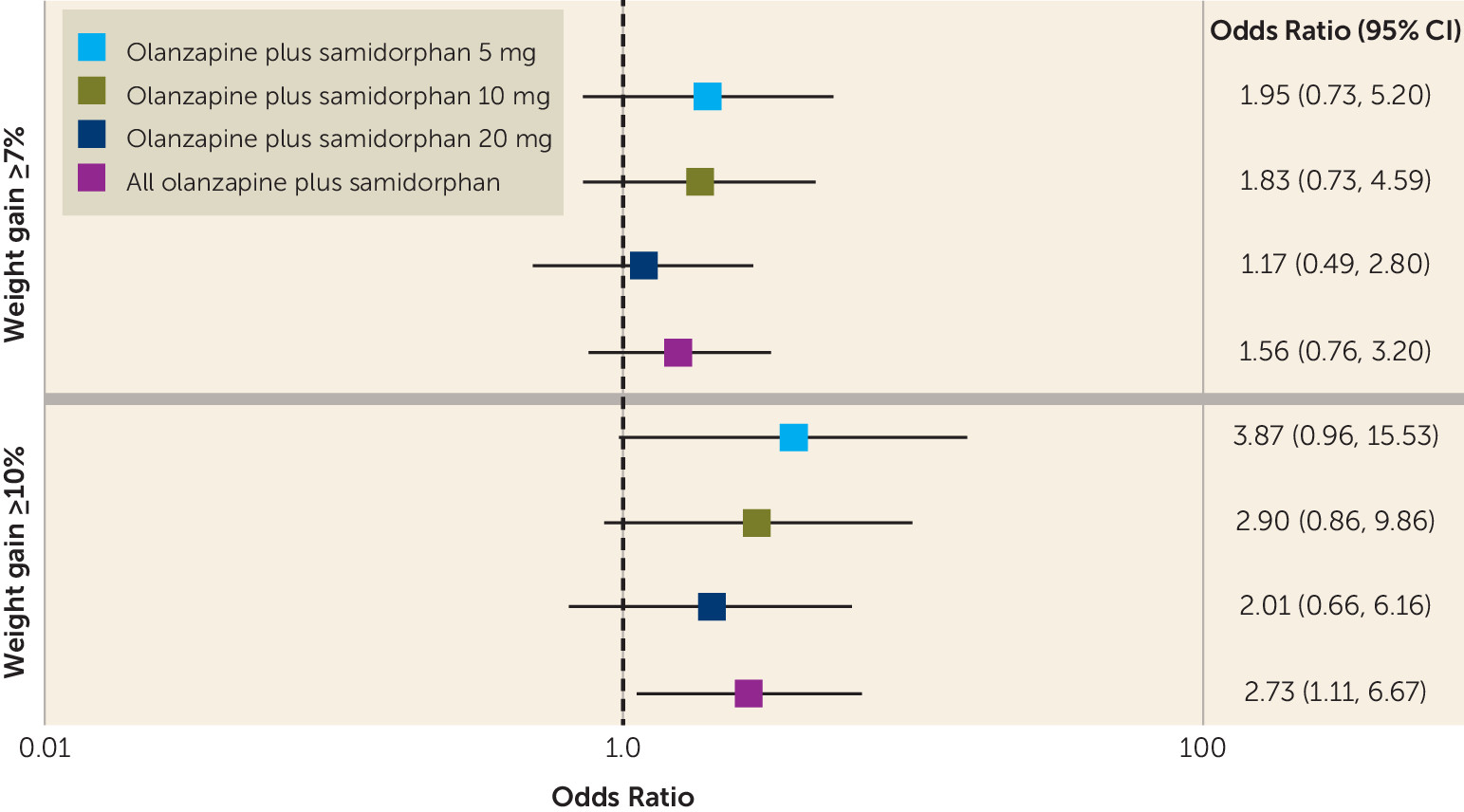In comparative effectiveness trials of schizophrenia, olanzapine is one of the most efficacious antipsychotics, and in long-term studies it has a lower rate of discontinuation due to lack of efficacy compared with other first-line antipsychotics (
1–
3). In the landmark Clinical Antipsychotic Trials of Intervention Effectiveness (CATIE) study, only 15% of patients treated with olanzapine discontinued treatment because of lack of efficacy, compared with 24%−28% of patients treated with other antipsychotics (
2). In addition, short-term trials of olanzapine have reported significant symptom improvement in patients with schizophrenia (
4,
5) as well as significantly sustained response in relapse prevention (
6). However, the clinical utility of olanzapine has been limited by an association with comparatively greater weight gain and metabolic dysregulation (
7,
8). Overall, body weight gain of ≥7% has been observed in 22%−86% of olanzapine-treated patients, depending on prior antipsychotic exposure and duration of treatment (
2,
3,
9).
Preclinical studies have provided evidence for a critical role of the opioid system in mediating food reward, feeding behavior, and metabolism. For example, decrease in weight gain has been reported in μ-, κ-, and δ-opioid receptor knockout mice, despite no differences in caloric intake in μ- and κ-opioid receptor knockouts (
10–
12). Thus, adding an opioid antagonist to CNS-active drugs may mitigate metabolic dysregulation. Samidorphan is a new compound that has been demonstrated in vivo to function as a µ-opioid antagonist (
13). In vitro, samidorphan binds with high affinity to human μ-, κ-, and δ-opioid receptors and acts as an antagonist at μ-opioid receptors and a partial agonist at κ- and δ-opioid receptors (
14,
15). Samidorphan was found in both preclinical and phase 1 clinical studies to mitigate weight gain associated with olanzapine (
16,
17). In a recent proof-of-concept study in healthy volunteers, mean weight gain over the course of 3 weeks was significantly less in patients treated with olanzapine plus samidorphan compared with those treated with olanzapine alone (2.2 kg [SD=1.4] compared with 3.1 kg [SD=1.9]) (
17). The combination drug formulation of olanzapine plus samidorphan is intended to provide the antipsychotic efficacy of olanzapine while mitigating the weight gain and concomitant metabolic abnormalities commonly associated with olanzapine alone.
In this proof-of-concept, placebo-controlled phase 2 study, we evaluated the efficacy, safety, and tolerability of the combination of olanzapine and samidorphan in patients with schizophrenia. The study compared the antipsychotic efficacy and safety of olanzapine plus fixed doses of samidorphan relative to olanzapine plus placebo, with a specific safety focus on the evaluation of the hypothesized weight gain mitigation effect of olanzapine plus samidorphan relative to olanzapine plus placebo.
Methods
This was an international multicenter safety, tolerability, and dose-ranging phase 2 study conducted from June 2013 to March 2015. The study was conducted in accordance with the Declaration of Helsinki and Good Clinical Practice Guidelines agreed on by the International Conference on Harmonization, 1997. The study protocol, amendments, and informed consent forms were approved by independent ethics committees or institutional review boards for all sites.
Study Design
The primary aims of the study were to assess the antipsychotic efficacy and safety of olanzapine in combination with samidorphan compared with olanzapine plus placebo for the treatment of schizophrenia, including adverse events and weight gain. Secondary goals were 1) to explore the relationship between weight mitigation effects of the olanzapine plus samidorphan combination and the amount of weight gained over the course of 1-week exposure to open-label olanzapine prior to randomization, and 2) to assess whether samidorphan exhibited a dose effect when combined with olanzapine.
The study consisted of a 1-month screening phase, after which patients were switched from their current treatment to receive 1 week of open-label olanzapine. After the olanzapine lead-in phase, patients entered a 12-week double-blind treatment phase (hereafter referred to as the treatment phase) consisting of open-label olanzapine (5–20 mg/day) coadministered with a blinded dose of study medication (samidorphan at 5 mg/day, 10 mg/day, or 20 mg/day, or placebo), followed by a 12-week extension phase as well as a 4-week safety follow-up. The 1-week open-label olanzapine lead-in was utilized to detect early weight gain for subsequent stratification in randomization, to identify the early-weight-gain population, and to test patient toleration of olanzapine. The olanzapine dosage was selected and titrated by study investigators on the basis of patient needs throughout the study and in line with current clinical practice. Patients who completed the olanzapine lead-in were enrolled in the treatment phase and were randomly assigned in a 1:1:1:1 ratio to one of four treatment groups: olanzapine plus samidorphan at 5 mg/day, 10 mg/day, or 20 mg/day or olanzapine plus matched placebo (see Figure S1 in the online supplement). Randomization was stratified by weight change during the 1-week olanzapine lead-in period into three strata: no weight gain, weight gain <1 kg, and weight gain ≥1 kg.
After completing the 12-week double-blind treatment phase, patients transitioned to the extension phase, where they received 12 weeks of active treatment with olanzapine plus samidorphan. Patients who had been assigned to one of the active samidorphan arms continued on the same dosage of samidorphan, and those who had been on placebo started 20 mg/day of samidorphan in addition to olanzapine (see Figure S1). In the extension phase, patients and study personnel were aware that all patients would receive olanzapine plus samidorphan, but they were blind to the dosage that patients received. The transition of patients from placebo to olanzapine plus samidorphan in the extension phase was done in a blinded manner via an interactive web response system.
Patients who exhibited early weight gain were identified at the end of the 1-week olanzapine lead-in period, as it is known that patients who exhibit early weight gain with olanzapine treatment are likely to gain weight overall (
18).
Patients
To be included in the study, patients had to be 18–50 years of age; have a diagnosis of schizophrenia (based on DSM-IV-TR criteria); be clinically stable (a score ≤80 on the Positive and Negative Syndrome Scale [PANSS] and a score ≤3 on the Clinical Global Impressions [CGI] severity scale); have maintained a stable body weight for ≥3 months prior to screening (≤5% change by history); and have a body mass index in the range of 17–30 at screening. Patients had not been exposed to olanzapine, clozapine, mesoridazine, chlorpromazine, or thioridazine for more than 1 week within 1 year prior to screening, or at any time in the 3 months before screening. The use or anticipated use of over-the-counter drugs for weight reduction, systemic steroids, or antipsychotic medications, among others, within 60 days before screening was prohibited. Patients were excluded if they were started on their first antipsychotic treatment within the past 12 months or had symptoms lasting <2 years.
Patients who were taking antipsychotic medication at the time of screening were tapered off of that medication within 2 weeks after initiation of the treatment phase. All patients provided written informed consent before entering the study.
Study Assessments
The primary efficacy endpoint was absolute change in PANSS total score from baseline (randomization) to the end of the treatment phase (week 12) for all of the olanzapine plus samidorphan groups compared with the olanzapine plus placebo group. Secondary endpoints included percent change in body weight and the proportion of patients who exhibited significant weight gain (≥7% and ≥10%) from baseline to the end of the treatment phase. Efficacy, safety, and change in body weight were also assessed throughout the 12-week extension phase.
Safety evaluations were carried out over the full study period and included adverse events, clinical laboratory tests (chemistry, hematology, and urinalysis), ECG, vital signs, and physical examination. Blood samples were taken at screening, during the olanzapine lead-in phase, and throughout the active study period for assessment of lipid and glycemic measures.
Statistical Analysis
The efficacy population included all patients who underwent randomized treatment assignment and received at least one dose of study drug and had at least one postbaseline PANSS assessment. Absolute change from baseline to week 12 in PANSS score was analyzed using a two-sided mixed model for repeated measures (MMRM). For the primary analysis, all patients in the olanzapine plus samidorphan treatment group were pooled for comparison with those in the olanzapine plus placebo group, with an equivalence margin of 10 points. Analyses of individual dosage levels were to be performed only if equivalence was demonstrated. Percent change in body weight from baseline to week 12 for the olanzapine plus samidorphan treatment group and the individual olanzapine plus samidorphan treatment groups was also analyzed using an MMRM model. The proportion of patients with significant weight gain (≥7% and ≥10% change from baseline) was analyzed using the Cochran-Mantel-Haenszel method to adjust for the olanzapine lead-in period weight change strata. Descriptive statistics were generated for the change from baseline in PANSS score and weight.
Percent change in body weight and proportion of patients with significant weight gain were evaluated in all patients as well as a subset of patients exhibiting early weight gain (>0 kg). The early-weight-gain analysis population included all patients who gained weight during the 1-week open-label olanzapine lead-in period and had at least one postbaseline weight assessment. Safety was assessed in all patients who underwent randomized treatment assignment and received at least one dose of study drug.
A sample size of 280 patients (70 per treatment group for olanzapine plus placebo and olanzapine plus samidorphan at 5 mg/day, 10 mg/day, and 20 mg/day) was determined to provide 95% power to demonstrate equivalence in change in PANSS score from randomization to week 12 of all patients receiving olanzapine plus samidorphan compared with those receiving olanzapine plus placebo, with an equivalence margin of 10 points.
Discussion
Treatment with olanzapine plus samidorphan resulted in antipsychotic efficacy equivalent to olanzapine plus placebo, as assessed by PANSS total score from baseline to week 12 within a predefined equivalence margin of 10. The effect of olanzapine plus samidorphan in mitigating olanzapine-induced weight gain was observed through multiple endpoints, including percent change in body weight from baseline and the proportion of patients who gained ≥10% of baseline body weight (representative of a clinically meaningful weight gain). Additionally, there was an early and sustained stabilizing effect of olanzapine plus samidorphan on body weight. Overall, there was less weight gain with olanzapine plus samidorphan treatment than with olanzapine plus placebo, and the differences were statistically significant. A larger treatment effect was seen in patients who experienced early weight gain. After 12 weeks of treatment with olanzapine plus samidorphan, in the full study population there was 37% less weight gain from baseline compared with the olanzapine plus placebo group, and patients who gained weight during the olanzapine lead-in phase (early weight gain) had 51% less weight gain from baseline compared with the olanzapine plus placebo group. Consistent with these observations, patients in the olanzapine plus placebo group were 2.7-fold more likely to gain ≥10% of baseline weight than those in the olanzapine plus samidorphan group, and patients in the olanzapine plus placebo group who experienced early weight gain were 4.1-fold more likely to gain ≥10% of baseline weight than those in the olanzapine plus samidorphan group.
Antipsychotic-induced weight gain generally has a rapid onset and can occur in the first few weeks of treatment (
19,
20)—an effect that was seen in all treatment groups during the first 2 weeks of this study. Thus, the addition of samidorphan mitigates olanzapine-associated weight gain but does not completely prevent it. Rather, treatment with olanzapine plus samidorphan changed the trajectory of weight gain over the remainder of the study period: patients in the olanzapine plus placebo group continued to gain weight throughout the treatment phase, whereas treatment with olanzapine plus samidorphan mitigated further weight gain. In addition, during the extension phase, treatment with olanzapine plus samidorphan was not associated with continued weight gain in patients who were switched from olanzapine plus placebo to olanzapine plus samidorphan at 20 mg/day, and the trend of weight gain from the first 12-week treatment phase when receiving olanzapine plus placebo was reversed in these patients. Of note, when examining the effects of potential weight-mitigating pharmacotherapies, efficacy has been more pronounced when testing begins before the onset of weight gain (
21,
22). Therefore, we focused on testing the prevention of weight gain and have designed our ongoing clinical studies to evaluate this approach, as opposed to treatment of established weight gain or obesity associated with antipsychotics. The mitigation of weight gain by samidorphan appears to be specific to weight gain associated with use of olanzapine, as samidorphan was not found to be associated with significant weight changes in monotherapy in patients with a binge-eating disorder (
23), in patients with alcohol dependence (
24), or in healthy volunteers (
17). Somnolence, sedation, dizziness, and constipation occurred more frequently in patients receiving samidorphan. Other safety measures for olanzapine plus samidorphan were comparable to olanzapine plus placebo.
This study has informed dosage selection for further study. Olanzapine plus samidorphan at 10 mg/day was seen to be an effective dosage, with a weight gain pattern similar to the 20 mg/day dosage and superior to the 5 mg/day dosage. As overall adverse events were higher at 20 mg/day, olanzapine plus samidorphan at 10 mg/day was selected as the dosage to advance into phase 3 testing. Administration of olanzapine plus samidorphan at 10 mg/day resulted in greater effects on antipsychotic efficacy and mitigation of weight gain compared with olanzapine plus samidorphan at 5 mg/day. Furthermore, olanzapine plus samidorphan at 20 mg/day did not confer additional benefit (compared with olanzapine plus samidorphan at 10 mg/day) and had a higher rate of adverse events compared with the other dosages; hence, the combination of olanzapine and samidorphan at 10 mg/day was selected for further investigation in phase 3 studies.
The use of atypical antipsychotics in clinical practice has improved outcomes for patients with schizophrenia; however, extrapyramidal symptoms, weight gain, and metabolic syndrome continue to be significant concerns. High rates of obesity, cardiovascular disease, and type 2 diabetes are seen in patients with schizophrenia (
25) and contribute to poor quality of life and high morbidity and mortality in this patient population (
26). Additionally, metabolic effects of antipsychotics pose a significant challenge because of their negative impact on long-term treatment adherence, which leads to poorer psychiatric treatment outcomes (
27).
Although several mechanisms of metabolic syndrome have been extensively explored both centrally and peripherally, weight gain and metabolic dysfunction associated with antipsychotic use are not fully understood (
7,
19,
28,
29). Several potential new treatment options, such as metformin (
30–
32), topiramate (
33), and mifepristone (
34,
35), have been examined for their ability to mitigate antipsychotic-induced weight gain (
36). Of these potential treatments, a common limitation is that patients have gained a significant amount of weight and/or have developed metabolic dysfunction prior to treatment initiation. The combination of olanzapine and samidorphan assessed in this study represents a new mechanistic approach toward addressing olanzapine-induced weight gain, whereby treatment is initiated before significant weight gain and metabolic dysfunction have occurred.
One limitation of the study is that the design included a 1-week open-label olanzapine lead-in period, which was incorporated to identify patients who could not tolerate olanzapine and with the aim of enhancing the ability to detect weight gain, because it is known that patients who exhibit early weight gain with olanzapine treatment are likely to gain weight overall (
18). Thus, it is possible that the effects of samidorphan were masked because of the olanzapine lead-in phase, as metabolic effects of olanzapine are robust and occur within a few days (
37) and even after one dose (
38). An additional limitation is that only patients with stable symptoms were included, and therefore efficacy (assessed by the PANSS) was not fully explored. In addition, the inclusion of potentially nonfasting blood samples makes interpretation of the metabolic parameters difficult. Analysis was based on the collection of precise repeated measures of weight that may be difficult to replicate in non-research settings. Likewise, because of the small subsample size of patients experiencing ≥7% and ≥10% body weight gain, the statistical separation between olanzapine plus samidorphan and olanzapine plus placebo should be interpreted with caution, as this study was not powered to look for these differences in categorical weight gain. Another potential limitation of the study is that the dosage of olanzapine was not predefined throughout the study but was selected and titrated by the investigators on the basis of individual patient needs and clinical condition. The sample was predominantly male and did not include patients with acute psychosis, who constitute an essential population in the treatment and management of schizophrenia. Lastly, the trial duration was relatively short compared with the time course of olanzapine-induced weight gain.





